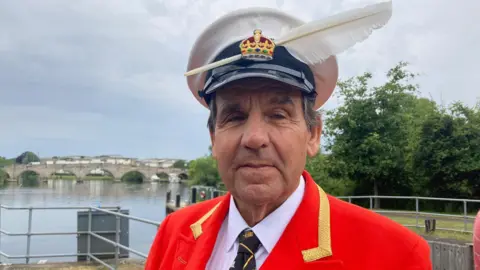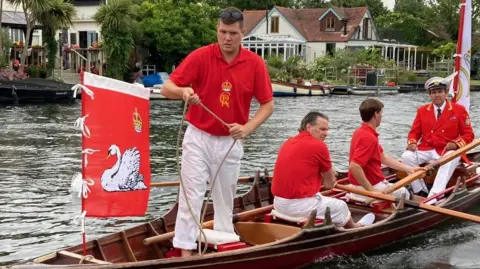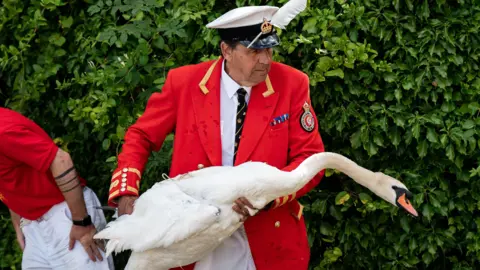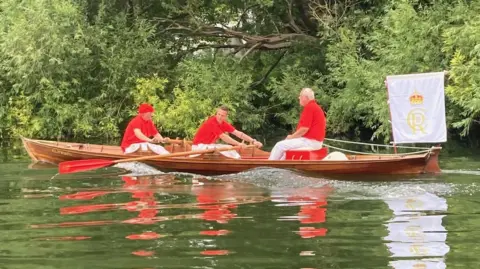‘Swan uppers’ hope numbers recover after avian flu
 Sean Coughlan
Sean CoughlanThe annual colourful medieval tradition of counting swans on the River Thames has begun, with the hope that numbers might have recovered from last year’s 40% decline caused by avian flu.
“Swan upping” is a royal census of swans on the river, with last year’s five-day search revealing a “quite disastrous” impact of the disease on the swan population.
The count is carried out every July by brightly-dressed crews of “swan uppers” in rowing boats over five days.
When they see young swans they shout out “all up” and stop to weigh and measure the swans, before releasing them back into the water.
 Sean Coughlan
Sean CoughlanThe swan uppers began their journey on a rainy Monday morning in west London and will reach Abingdon in Oxfordshire on Friday.
It’s a quirky mix of vivid royal spectacle and conservation project, with spectators lining riverbanks and the backs of suburban gardens to watch this flotilla sailing past.
Last year’s count only found 94 cygnets, a major decline in the swan population.
“Fortunately this year we have had far fewer reported cases of avian influenza, which is excellent news,” says David Barber, the King’s swan marker.
As a mark of his position he has a swan’s feather in his cap and wears a bright scarlet jacket, as he is rowed along the river, with boats flying flags and historical emblems.
But when we stop to get through a lock, the King’s swan marker has a serious message about this annual summer journey.
In particular he’s concerned about the impact of anti-social behaviour against the swan population.
“Attacks by air rifles and catapults are increasing. It’s appalling and it’s getting worse,” says Mr Barber.
“It’s a job to stop them,” says the swan marker, and he hopes that working with schools will help to educate young people away from mistreating swans.
 PA Media
PA Media Sean Coughlan
Sean CoughlanMr Barber says the swan upping event is “unique” and attracts people from all over the world. He wants to use the attention to improve protection for swans.
But he says that after such a big loss from avian flu last year that numbers “might not be back to where we were before”, but he hopes for some improvement.
Swan upping, which dates back to the middle ages, was a way of counting what had been valuable property – with any unmarked mute swans being the property of the Crown.
As well as the swan upping row boats, the census is accompanied by other support craft, including a number of historical boats that took part in the wartime Dunkirk evacuations in 1940, including the restored White Wing.
It’s an unexpected and rather eccentric spectacle, men with feathers in their cap, gliding serenely along the Thames, in search of swans.







